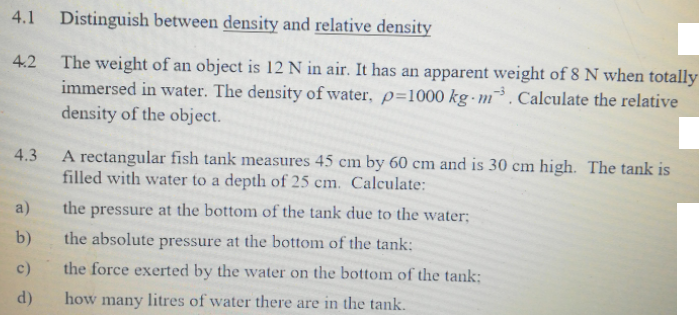4.1 Distinguish between density and relative density The weight of an object is 12 N in air. It has an apparent weight of 8 N when totally immersed in water. The density of water, p=1000 kg-m³. Calculate the relative density of the object. 4.2 A rectangular fish tank measures 45 cm by 60 cm and is 30 cm high. The tank is filled with water to a depth of 25 cm. Calculate: 4.3 a) the pressure at the bottom of the tank due to the water; b) the absolute pressure at the bottom of the tank: c) the force exerted by the water on the bottom of the tank: d) how many litres of water there are in the tank.
4.1 Distinguish between density and relative density The weight of an object is 12 N in air. It has an apparent weight of 8 N when totally immersed in water. The density of water, p=1000 kg-m³. Calculate the relative density of the object. 4.2 A rectangular fish tank measures 45 cm by 60 cm and is 30 cm high. The tank is filled with water to a depth of 25 cm. Calculate: 4.3 a) the pressure at the bottom of the tank due to the water; b) the absolute pressure at the bottom of the tank: c) the force exerted by the water on the bottom of the tank: d) how many litres of water there are in the tank.
University Physics Volume 1
18th Edition
ISBN:9781938168277
Author:William Moebs, Samuel J. Ling, Jeff Sanny
Publisher:William Moebs, Samuel J. Ling, Jeff Sanny
Chapter14: Fluid Mechanics
Section: Chapter Questions
Problem 44P: A straightforward method of finding the density of an object is to measure its mass and then measure...
Related questions
Question

Transcribed Image Text:4.1
Distinguish between density and relative density
The weight of an object is 12 N in air. It has an apparent weight of 8 N when totally
immersed in water. The density of water, p=1000 kg-m³. Calculate the relative
density of the object.
4.2
A rectangular fish tank measures 45 cm by 60 cm and is 30 cm high. The tank is
filled with water to a depth of 25 cm. Calculate:
4.3
a)
the pressure at the bottom of the tank due to the water;
b)
the absolute pressure at the bottom of the tank:
c)
the force exerted by the water on the bottom of the tank:
d)
how many litres of water there are in the tank.
Expert Solution
This question has been solved!
Explore an expertly crafted, step-by-step solution for a thorough understanding of key concepts.
This is a popular solution!
Trending now
This is a popular solution!
Step by step
Solved in 3 steps

Recommended textbooks for you

University Physics Volume 1
Physics
ISBN:
9781938168277
Author:
William Moebs, Samuel J. Ling, Jeff Sanny
Publisher:
OpenStax - Rice University

An Introduction to Physical Science
Physics
ISBN:
9781305079137
Author:
James Shipman, Jerry D. Wilson, Charles A. Higgins, Omar Torres
Publisher:
Cengage Learning

University Physics Volume 1
Physics
ISBN:
9781938168277
Author:
William Moebs, Samuel J. Ling, Jeff Sanny
Publisher:
OpenStax - Rice University

An Introduction to Physical Science
Physics
ISBN:
9781305079137
Author:
James Shipman, Jerry D. Wilson, Charles A. Higgins, Omar Torres
Publisher:
Cengage Learning